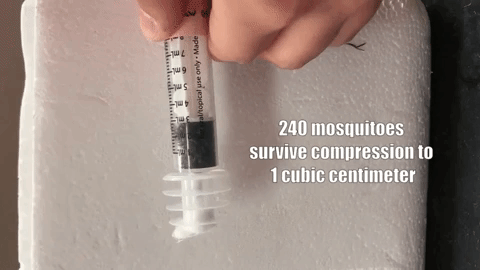240 mosquitoes compressed in cylinder tubes still do not die, waiting for the day to spread the destruction to the species
This is all for the purpose of minimizing disease-related deaths from mosquitoes.
With blood, sweat and dozens of stings, the photographer finally managed to capture perfect images of mosquitoes
Not sharks, not tigers, wolves, lions, but mosquitoes are the most dangerous animals on the planet for humans. Every year, millions of people die from diseases spread by mosquitoes. Fortunately, scientists have a new plan to reduce the amount of mosquitoes, but they need to send hundreds of thousands of mosquitoes to many parts of the world.
You may think that a large and specialized means of transport is needed to contain huge amounts of mosquitoes, but no, scientists transfer dozens, even hundreds, of thousands of mosquitoes just like letters. It turns out that mosquitoes can survive in an extremely narrow environment, even if transported over long distances, they live well in tight spaces rather than spacious due to limited collision.
How tight is it? According to new research published in the Journal of Insect Science, the number is staggering, 240 animals can live well in a space of only 1 cubic centimeter. This means a teaspoon will hold 1200 cubes and a 10ml cylinder can hold 2500 mosquitoes. To make it easier to imagine, think of a small glass to drink, this glass can hold up to 7200 mosquitoes.

This study was conducted by the University of Mexico to find the best way to transport mosquitoes. They experiment in a variety of conditions, both in the laboratory and on the actual move by sending mail overnight.
In 1950, scientists found an effective way to reduce the number of dangerous insects without spraying chemicals, which would correct their reproductive pathways. Basically, you will need a large number of male insects, then sterilize them without harming them. After that, you will drop these individuals naturally for them to mate. Over time, infertile individuals will compete with normal males, reducing the fertility rate.
The first insect tested in this way is the screw fly (screwworm fly) and achieved great success. Since then, this technique has been applied to significantly reduce the number of harmful insects. And now, researchers want to test on the world's most dangerous species, mosquitoes.

An individual male mosquito.
But according to researcher Immo Hansen, using this technique on mosquitoes will be quite difficult, because male mosquitoes rarely move.'In the whole life cycle, they only fly 100, 200m, no more ,' Hansen said, so we need to bring mosquitoes to the place, not expecting them to fly on their own and that's why the houses Researching how to safely transport mosquitoes as much as possible In addition to detecting mosquitoes that can live well in tight environments, researchers also realize that the ideal temperature for them to be least active is 14 ° C.
- 11 reasons mosquitoes are the most dangerous species on Earth
- New explanation about mosquitoes that cannot spread HIV
- Bacteria kill mosquitoes that spread malaria
- Mosquitoes' mosquitoes to block malaria
- The disease spreads 'global threat'
- Mosquito-changing mosquitoes
- Mosquitoes differentiate their species with a cry
- Creating mosquitoes that cannot transmit disease
- Consequences when mosquitoes become extinct
- The paradox of flying mosquitoes makes them extremely scary
- Interesting findings about mosquitoes
- The fungus kills 99% of mosquitoes in 45 days
 Why do potatoes have eyes?
Why do potatoes have eyes? 'Tragedy' the world's largest carnivorous life: Death becomes ... public toilet
'Tragedy' the world's largest carnivorous life: Death becomes ... public toilet Tomatoes were once considered 'poisonous' for 200 years
Tomatoes were once considered 'poisonous' for 200 years Detecting microscopic parasites on human face
Detecting microscopic parasites on human face